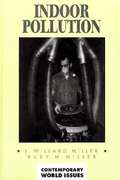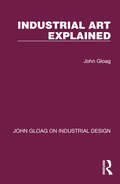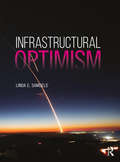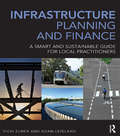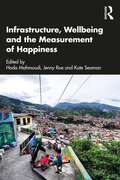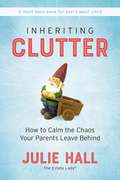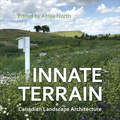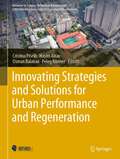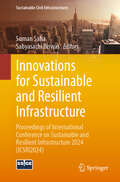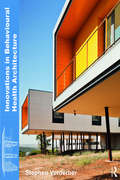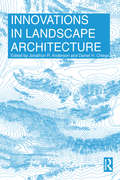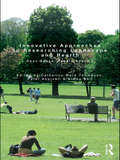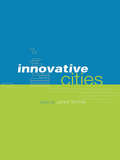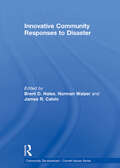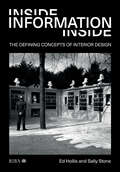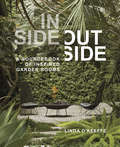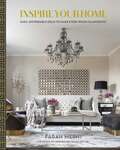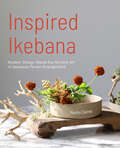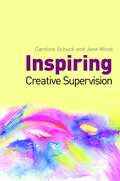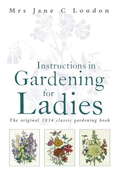- Table View
- List View
Indoor Pollution
by E. Willard Miller Ruby M. MillerThe presence of polluted air in the home from heating and cooking food is as old as civilization itself. In modern times the general public only became aware of the health hazards when the number of household chemicals increased dramatically in the twentieth century. Few governmental regulations have been passed to regulate the home environment. The concept that the home is a man's castle has delayed the passing of governmental regulations that control the quality of the indoor environment. Standards are, however, being established by many private organizations.
Industrial Art Explained (John Gloag On Industrial Design Ser.)
by John GloagOriginally published in 1934 this book became recognised as one of the principal standard works on industrial design and industrial architecture. The chapters explain the complete operation, character and background history of industrial art, its relation to architecture, materials, industrial production and retail distribution. It is fully illustrated with line drawings and photographs.
Infrastructural Optimism
by Linda C. SamuelsInfrastructural Optimism investigates a new kind of twenty-first-century infrastructure, one that encourages a broader understanding of the interdependence of resources and agencies, recognizes a rightfully accelerated need for equitable access and distribution, and prioritizes rising environmental diligence across the design disciplines. Bringing together urban history, case studies, and speculative design propositions, the book explores and defines infrastructure as the basis for a new form of urbanism, emerging from the intersection of architecture, landscape architecture, and urban design. In defining this new infrastructure, the book introduces new dynamic and holistic performance metrics focused on "measuring what matters" over growth for the sake of growth and twelve criteria that define next generation infrastructure. By shifting the focus of infrastructure – our largest public realm – to environmental symbiosis and quality of life for all, design becomes a catalytic component in creating a more beautiful, productive, and optimistic future with Infrastructural Urbanism as its driver. Infrastructural Optimism will be invaluable to design, non-profit and agency professionals, and faculty and students in the fields of architecture, landscape architecture, and urban design, working in partnership with engineers, hydrologists, ecologists, urban planners, community members, and others who shape the built environment through the expanded field of infrastructure.
Infrastructure Planning and Finance: A Smart and Sustainable Guide
by Vicki Elmer Adam LeiglandInfrastructure Planning and Finance is a non-technical guide to the engineering, planning, and financing of major infrastucture projects in the United States, providing both step-by-step guidance, and a broad overview of the technical, political, and economic challenges of creating lasting infrastructure in the 21st Century. Infrastructure Planning and Finance is designed for the local practitioner or student who wants to learn the basics of how to develop an infrastructure plan, a program, or an individual infrastructure project. A team of authors with experience in public works, planning, and city government explain the history and economic environment of infrastructure and capital planning, addressing common tools like the comprehensive plan, sustainability plans, and local regulations. The book guides readers through the preparation and development of comprehensive plans and infrastructure projects, and through major funding mechanisms, from bonds, user fees, and impact fees to privatization and competition. The rest of the book describes the individual infrastructure systems: their elements, current issues and a 'how-to-do-it' section that covers the system and the comprehensive plan, development regulations and how it can be financed. Innovations such as decentralization, green and blue-green technologies are described as well as local policy actions to achieve a more sustainable city are also addressed. Chapters include water, wastewater, solid waste, streets, transportation, airports, ports, community facilities, parks, schools, energy and telecommunications. Attention is given to how local policies can ensure a sustainable and climate friendly infrastructure system, and how planning for them can be integrated across disciplines.
Infrastructure, Wellbeing and the Measurement of Happiness
by Roe Jenny Seaman Kate Mahmoudi HodaThis book takes an interdisciplinary approach to our understanding of infrastructure, and it’s influence on happiness and wellbeing, by examining the concept from economic, human development, architectural, urban planning, psychological, and ethical points of view. Providing insights from both research and practice the volume discusses how to develop happier cities and improve urban infrastructure for the wellbeing of the whole population. The book puts forth the argument that it is only in understanding the true nature of infrastructure’s reach – how it connects, supports, and enlivens human beings – that we can truly begin to understand infrastructure’s possibilities. It connects infrastructure to that most elusive of human qualities – happiness – examining the way infrastructure is fundamentally tied to human values and human well-being. The book seeks to suggest novel approaches, identify outmoded undertakings, and define new possibilities in order to maximize infrastructure’s impact for all people – with a focus on diversity, inclusion and equity. In seeking to define infrastructure broadly and examine its possibilities systematically this book brings together theory and evidence from multiple disciplinary perspectives including, sociology, urban studies, architecture, economics, and public health in order to advance a startling claim – that our lives, and the lives of others, can be substantively improved by greater adhesion to the principles and practices of infrastructure design for happiness and wellbeing.
Inheriting Clutter: How to Calm the Chaos Your Parents Leave Behind
by Julie HallEveryday hundreds of adult children become middle-aged orphans when their elderly parents pass away, leaving behind more than just memories.You&’ve heard the horror stories: arguments over stuff, an inheritance lost forever when easily deceived parents are scammed, siblings estranged, an adult heir taken from daily responsibilities for months because of the enormous task of clearing out a childhood home. It doesn&’t have to be that way.The Estate Lady, professional estate liquidator Julie Hall, knows what to do. Whether your parents are still living or you&’re caught in the middle of a crisis, Inheriting Clutter: How to Calm the Chaos Your Parents Leave Behind has solutions. Hall provides trustworthy counsel on how to:Divide your parents&’ estate with peace of mindMinimize fighting with siblings during the estate settlement processClear out the family home in thirty days or lessIdentify potential items of value in the homeHave &“that conversation&” with your parentsPrepare your own children for the futureThe Estate Lady offers guidance for any executor, heir, or beneficiary, sharing some of her most fascinating stories as well as helpful checklists of the things that need to be done now and at the time of your loss.Inheriting Clutter gives you practical, effective steps for liquidating and distributing your parents&’ assets in a way that both honors them and promotes family harmony for generations to come.
Innate Terrain: Canadian Landscape Architecture
by Alissa NorthInnate Terrain addresses the varied perceptions of Canada’s natural terrain, framing the discussion in the context of landscapes designed by Canadian landscape architects. This edited collection draws on contemporary works to theorize a distinct approach practiced by Canadian landscape architects from across the country. The essays – authored by Canadian scholars and practitioners, some of whom are Indigenous or have worked closely with Indigenous communities – are united by the argument that Canadian landscape architecture is intrinsically linked to the innate qualities of the surrounding terrain. Beautifully illustrated, Innate Terrain aims to capture distinct regional qualities that are rooted in the broader context of the Canadian landscape.
Innovating Strategies and Solutions for Urban Performance and Regeneration (Advances in Science, Technology & Innovation)
by Haşim Altan Cristina Piselli Osman Balaban Peleg KremerThis book focuses on enhancing urban regeneration performance and strategies that pave the way toward sustainable urban development models and solutions. The book at hand thoroughly examines the latest studies on the regeneration of urban areas and attempts at alleviating the negative impacts associated with high population density and urban heat effects. It gathers contributions that combine theoretical reflections and international case studies on urban regeneration and transformation with the single goal of tackling existing social and economic imbalances and developing new solutions. The primary audience of this book will be from the field of architecture and urban planning, offering new insights on how to address the myriad of problems that our cities are facing.
Innovations for Sustainable and Resilient Infrastructure: Proceedings of International Conference on Sustainable and Resilient Infrastructure 2024 (ICSRI2024) (Sustainable Civil Infrastructures)
by Sabyasachi Biswas Suman SahaThis book aims to provide innovative solutions to the various problems faced during the infrastructural development across the globe. The book is highly focused on the following topics, but not limited to: innovative technologies in infrastructure, sustainable materials, smart cities, climate resilient infrastructures, and applications of AI and ML in infrastructure development. The contributions presented in this volume reflect the extensive research and innovative thinking of researchers and practitioners dedicated to shaping the future of sustainable infrastructure. It is anticipated that the knowledge shared through this conference proceedins book will inspire further advancements and collaborative efforts toward building sustainable and resilient infrastructure globally.
Innovations in Behavioural Health Architecture
by Stephen VerderberInnovations in Behavioural Health Architecture is the most comprehensive book written on this topic in more than 40 years. It examines the ways in which healthcare architecture can contribute, as a highly valued informational and reference source, to the provision of psychiatric and addictive disorder treatment in communities around the world. It provides an overview of the need for a new generation of progressively planned and designed treatment centres – both inpatient and outpatient care environments – and the advantages, challenges, and opportunities associated with meeting the burgeoning need for treatment settings of this type. Additional chapters address the specifics of geriatric psychiatry and its architectural ramifications in light of the rapid aging of societies globally and provide a comprehensive compendium of planning and design considerations for these places in both inpatient and outpatient care contexts. Finally, the book presents an expansive and fully illustrated set of international case studies that express state-of-the-art advancements in architecture for behavioural healthcare.
Innovations in Landscape Architecture
by Jonathon R. Anderson Daniel H. OrtegaThis inspiring and thought-provoking book explores how recent innovations in landscape architecture have uniquely positioned the practice to address complex issues and technologies that affect our built environment. The changing and expanding nature of "landscape" make it more important than ever for landscape architects to seek innovation as a critical component in the forward development of a contemporary profession that merges expansive ideas and applications. The editors bring together leading contributors who are experts in new and pioneering approaches and technologies within the fields of academic and professional landscape architecture. The chapters explore digital technology, design processes and theoretical queries that shape the contemporary practice of landscape architecture. Topics covered include: Digital design Fabrication and prototyping Emerging technology Visualization of data System theory Concluding the book are case studies looking at the work of two landscape firms (PEG and MYKD) and two academic departments (Illinois Institute of Technology and the Rhode Island School of Design), which together show the novel and exciting directions that landscape is already going in.
Innovative Approaches to Researching Landscape and Health: Open Space: People Space 2
by Simon Bell Catharine Ward Thompson Peter AspinallOur modern lifestyles often cause us to spend more time sitting behind a desk than being active outdoors. At the same time, our general health is deteriorating. The alarming rise in obesity, sedentary lifestyles and mental ill-health across the developed world has resulted in an urgent desire to understand how the environment, in particular the outdoor environment, influences health. This book addresses the growing interest in salutogenic environments - landscapes that support healthy lifestyles and promote well-being – and the need for innovative methods to research them. Drawing on multidisciplinary approaches from environmental psychology, health sciences, urban design, landscape architecture and horticulture, it questions how future research can be better targeted to inform policy and practice in health promotion. The contributing authors are international experts in researching landscape, health and the environment, drawn together by OPENspace directors who have a unique reputation in this area. This pioneering book is a valuable resource for postgraduate researchers and practitioners in both environmental and health studies.
Innovative Cities
by James SimmieInnovative Cities presents a unique international comparison of innovation in Amsterdam, London, Milan, Paris and Stuttgart. Based on research funded by the ESRC program on 'Cities: Competitiveness and Cohesion', it compares and contrasts the reasons why these sites are among the top ten innovative cities in Europe. Innovation is one of the key driving forces of economic growth in modern economies.The research reported here takes a careful and directly comparable look at what characteristics and conditions in the five cities have led to the flourishing of innovation in them. Researchers with detailed local knowledge have applied the same analytical tools and survey techniques to investigating this question and the result present a unique international comparison of innovation in the five cities.
Innovative Community Responses to Disaster (Community Development – Current Issues Series)
by Brent D. Hales, Norman Walzer and James R. CalvinIncreasingly, community leaders around the world face major natural and economic disasters that require them to find ways to rebuild both physical infrastructure and the local economy. Doing this effectively requires an understanding of how various parts of the community are interconnected, as well as information as to which revitalization approaches have succeeded in the past. Community investment in recovery is essential and, in some cases, may require local leaders to rethink how it can be financed and arranged. This book presents a conceptual framework based on the community capitals, and describes approaches that have succeeded in situations where local leaders have coordinated efforts to rebuild and revitalize local conditions. Contributions provide examples of successful approaches around the world, thus analysing potential strategies for addressing disasters of many different types in various cultural settings. In this way, the book provides insights into a variety of approaches based on applications of accepted community development theory and concepts. This book was originally published as a special issue of Community Development.
Inside Information: The defining concepts of interior design
by Edward Hollis Sally StoneEvery built structure has an interior: whether it takes the rough form of a rudimentary shelter, the grey walls of a hospital or the finessed decoration of a one-off residence. We spend most of our time inside buildings. Shut your eyes and you will find yourself in your own interior. You will always be inside. Mastering the language, thinking and history of the interior is critical to understanding and designing spaces. This essential primer transcends the boundaries and genres that often define interiors, providing a comprehensive view of the concepts and vocabulary of interior design. Written as an accessible ‘treasury’ of principal terms and ideas, Inside Information engages with the past, uncovering the future potential of the interior, and its design. Introduces the reader to 26 key terms, from ante- to zeitgeist. Covers areas of study from the very practical – structures, decoration and sustainability – to the philosophical – gender, space and light. Features sources, ranging from: Le Corbusier to Norman Foster; Jacques Derrida to Noam Chomsky; Virginia Woolf to George Orwell. Highly illustrated with over 100 photographs and drawings.
Inside Outside: A Sourcebook of Inspired Garden Rooms
by Linda O'KeeffeAn inspiring guide to creating stylish and livable outdoor spaces An outdoor room is an extension of the home—a space that can used for entertaining, relaxing, cooking, playing, swimming, and more. In spaces large and small, outdoor rooms offer a retreat from daily life and a connection to nature. In Inside Outside, Linda O&’Keeffe—former creative director of Metropolitan Home—will inspire you to create an outdoor living space that offers an oasis of comfort and style. O&’Keeffe uses the language of interior design to inform her approach to exterior design, focusing on space, structure, movement, mood, and furniture. Inside Outside is filled with private gardens from North America and Europe that are inspiring and illustrative examples. From dramatic topiaries and black tulips in Massachusetts to the living wall in the courtyard of a Paris penthouse, fresh ideas permeate both the gardens found within this book and the design thinking behind them.
Inside the Flame: The Joy of Treasuring What You Already Have
by Christina WatersInside the Flame invites readers to unplug their computers, cell phones, and televisions and plunge back into overlooked nooks and crannies of everyday experience. We've lost touch with the richness of the tangible and with it our reverence for the physical world. Our ability to focus on the here and now is in crisis. By illuminating ways to take a closer look at the world around, Inside the Flame will help readers heighten their surroundings, tune the volume more precisely, and live lives that are fuller, richer, more mindful, and more compassionately interwoven with others. Inside the Flame illustrates how attentive experience brings the world close, and how the world responds by infusing us with bold colors, memorable textures, and a more widely open heart.From the Hardcover edition.
Inspire Your Home: Easy Affordable Ideas to Make Every Room Glamorous (Inspire Your Home)
by Farah MerhiInstagram star and founder of Inspire Me! Home Décor shares her creative and elegant interior design secrets so you can create a glamorous yet cozy home without spending a fortune. Farah Merhi launched Inspire Me! Home Decor in 2012 as a creative outlet during a transitional time in her life. Farah was about to graduate college and planned to attend law school. Going through the motions and feeling unfulfilled in her career choice, she built up the courage to face her truth. Taking time off to figure herself out, Farah, through a remodel project in her home, had her “ah-ha” moment. The importance of taking care of your home, specifically in the way you clean, organize, and design, was instilled in her at a young age, but she didn’t realize how much of an impact her upbringing had until she owned her own home. Farah knew she had found her passion and calling, and was determined to inspire home owners to live their best lives in their homes. Farah believes that taking care of your home is essential to your peace of mind. Her design style is elegant and glamorous but infused with warmth and coziness, creating a welcoming feel with neutral color palletes, soft and inviting fabrics, and exquisite design details that can work in any room. She believes you can make a statement without sacrificing an inviting feel to your rooms. There is no right and wrong when it comes to designing your home and Farah encourages you to focus on the overall look and feel you desire, and her tips and advice will help guide you through the process. Starting with her most frequently asked questions about paint color versus wallpaper, lighting and rugs, home organization, and of course styling, Farah walks you through every room in the house from the mudroom to the kitchen and kids’ bedrooms. Along the way, she includes quick seasonal updates on a budget, suggested routines for maintaining your space, and her unique reward system, which includes small styling vignettes around your home. Woven throughout are Farah’s personal stories that will feel like you’re getting design advice from a close friend. Everyone deserves to walk into a beautifully decorated home every day—now you can, with the inspiration and practical tips in Inspire Your Home.
Inspired Ikebana: Modern Design Meets the Ancient Art of Japanese of Flower Arrangement
by Naoko ZaimaAesthetic Arrangements for the Artsy Minimalist#1 New Release in Folkcrafts, Japanese Gardens, Botany of Flowers, and Architectural PhotographyDiscover modern Ikebana, the Japanese art of floral design, to form and cultivate internal peace and creativity. You can create minimalist decor with Ikebana, otherwise known as Kado, a disciplined art form that brings together nature and the inner self through flower arrangement.Delight in the intentionally minimalist floral designs. Perfect for anyone interested in historic culture, flower arranging, Japanese art, or minimalist decorating. This beautifully-photographed instructional guide is a modern take on a centuries-old art. It's filled with simple-to-follow, step-by-step instructions that allow you to create stunning decor and learn how to make floral arrangements in various Ikebana styles using both fresh and dried flowers.The history of Kado, reimagined. Ikebana is a long-practiced, much respected artform with an intriguing history, and author Naoko Zaima is excited to share the story with you in this lovely Japanese art book and floral design book.Inside, you’ll find:Alluring simplistic design inspirations and pictures of IkebanaStories featuring the history of Ikebana and its impact on floral design through historyHow to make everything Kado—from floral bouquets to wreaths and more—accompanied by suggestions of the best flower arrangement tools to use for each projectIf you liked elevated arrangement books like Floret Farm's A Year in Flowers, Marie Kondo's Kurashi at Home, or Inspired by Nature, you’ll love Inspired Ikebana.
Inspired by Light: A design guide to transforming the home
by Sally StoreyLighting has undergone a revolution in recent years, with new tools and technologies at our disposal: never before have there been so many options to achieve the transformative effects of light. Yet all too often, lighting – which does not just enable functionality, but also mood, aesthetics and flow – is misunderstood, or plain badly done. With so many options available, it’s also all too easy to make mistakes; and with new technologies such as LEDs lasting a long time, these mistakes can be expensive. Offering practical insight and visual inspiration on successful lighting solutions and schemes, this is the most accessible lighting design guide, offering a toolbox of techniques to apply in practice. Written by one of the UK's leading lighting designers on both commercial and residential projects, it features a variety of real-world projects – large and small, old and new, interior and exterior, UK and global.
Inspiring Creative Supervision
by Jane Wood Caroline SchuckCreative supervision can be a stimulating and valuable alternative to questioning and discussion in the context of a supervision session. This book proposes using many different techniques and materials, as well as the rich experience of the imagination and the senses, and encourages the reader to go beyond the formal demands of their role, and feel inspired by creativity, spontaneity and experiential work. The authors draw together theory, research and practical exercises, and provide ideas for setting up and running creative supervision sessions, including how to get started. The ideas and techniques outlined in this book include the use of narrative, drawings and visualisation, and the authors also clearly explain how to make the best use of props and resources such as toys, objet trouvé and picture postcards. The innovative approach described in this book will be of interest to supervisors and non-supervisors alike. It will serve as a road map for expressive arts therapists, social workers, psychotherapists, psychologists and mental health and health care workers, and will also be an invaluable resource for other professionals such as teachers, mentors, coaches and human resources departments.
Install Your Own Solar Panels: Designing and Installing a Photovoltaic System to Power Your Home
by Philip Schmidt Joseph BurdickLabor and related costs account for more than half of the price of the average home solar installation. But homeowners can save thousands of dollars with this user-friendly manual, which follows the same process professional contractors use. Through detailed directions and step-by-step photos, veteran solar installer Joseph Burdick and seasoned builder Philip Schmidt teach you how to determine the size, placement, and type of installation you’ll need. This comprehensive DIY guide covers everything from assembling rooftop racking or building a ground-mount structure to setting up the electrical connections and making a battery bank for off-grid systems.
Instructions in Gardening for Ladies: The original 1834 classic gardening book
by Jane C LoudonHaving married a gardening expert, it seemed to Jane C Loudon, that everyone around her knew far more about plants and gardening than she did, but she quickly learned the art of horticulture from her husband and decided to pass his teachings on to other ladies to help them enjoy the delights of the garden. Gardening for Ladies was, and still is, an entirely practical book that describes how a lady can make the most of her garden in a clear and precise way. Digging over a flowerbed might have been work for a rough-handed, rope-muscled garden worker, but Jane explained how a lady could tackle the job without undue strain, and explained why it was necessary. The advice and instruction in this classic gardening book is as relevant today as it was when it was written 180 years ago.
Instructions in Gardening for Ladies: The original 1834 classic gardening book
by Jane C LoudonHaving married a gardening expert, it seemed to Jane C Loudon, that everyone around her knew far more about plants and gardening than she did, but she quickly learned the art of horticulture from her husband and decided to pass his teachings on to other ladies to help them enjoy the delights of the garden. Gardening for Ladies was, and still is, an entirely practical book that describes how a lady can make the most of her garden in a clear and precise way. Digging over a flowerbed might have been work for a rough-handed, rope-muscled garden worker, but Jane explained how a lady could tackle the job without undue strain, and explained why it was necessary. The advice and instruction in this classic gardening book is as relevant today as it was when it was written 180 years ago.
Instruments of Land Policy: Dealing with Scarcity of Land (Urban Planning and Environment)
by Thomas Hartmann Jean-David Gerber Andreas HengstermannIn dealing with scarce land, planners often need to interact with, and sometimes confront, property right-holders to address complex property rights situations. To reinforce their position in situations of rivalrous land uses, planners can strategically use and combine different policy instruments in addition to standard land use plans. Effectively steering spatial development requires a keen understanding of these instruments of land policy. This book not only presents how such instruments function, it additionally examines how public authorities strategically manage the scarcity of land, either increasing or decreasing it, to promote a more sparing use of resources. It presents 13 instruments of land policy in specific national contexts and discusses them from the perspectives of other countries. Through the use of concrete examples, the book reveals how instruments of land policy are used strategically in different policy contexts.
